Clematis villosa subsp. stanleyi
Clematis villosa DC. subsp. stanleyi (Hook.) Kuntze
Family: Ranunculaceae
Common names: feather duster, shock-headed peter (Eng.); pluimbossie, veerbossie (Afr.); bogopa (?) (Sotho); nyenu, ndengu (Wemba: Zambia).
Introduction
Clematis villosa subsp. stanleyi, previously known as Clematopsis scabiosifolia among other names, is a striking subshrub that typically grows to about 1 m tall. It produces large, pendulous flowers in shades ranging from white and cream to pale or deep pink, often with a sweet fragrance. Surprisingly, it remains relatively uncommon in cultivation. While this plant can be challenging to establish, especially in naturalistic or wild gardens, dedicated gardeners will be well rewarded. Once settled, it flourishes into a beautiful, ornamental plant adorned with abundant, large, and pleasantly scented blooms.
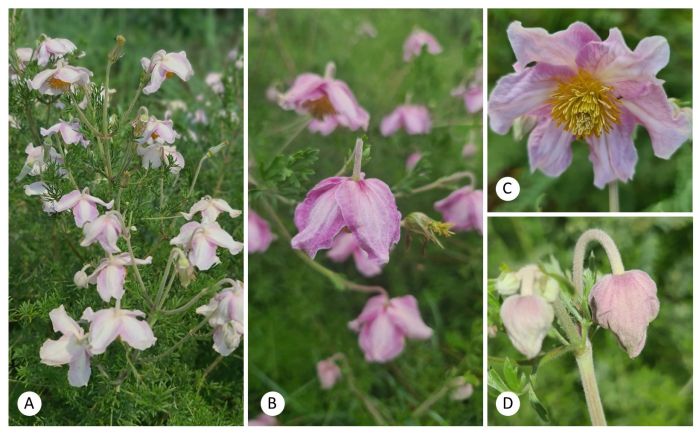
Fig. 1. Clematis villosa subsp. stanleyi habit and flowers. A, B, showing habit of the plants and hanging flowers. C, flower viewed from below (this is an atypical individual with more than 4 sepals). D, buds, showing immature petals protecting fertile parts while the flower develops. All photos: SP Bester.
Description
Description
This plant is a tall, perennial herb or small shrub, growing between 0.45 and 1.5 m in height. It regenerates annually from a woody rootstock and is covered in fine greyish to silvery hairs. The stems are longitudinally ribbed, while the leaves are arranged in opposite pairs, measuring 70–140 mm in length. The leaves are deeply divided (bipinnate), with each segment further subdivided into narrow, sharply pointed lobes approximately 20 mm long. The leaf stalk (petiole) is concave on top, convex beneath, and covered in soft hairs (villous).
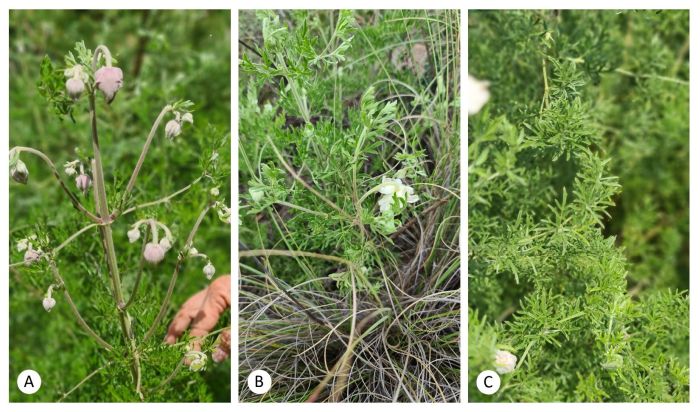
Fig. 2. Clematis villosa subsp. stanleyi leaves. A, showing opposite arrangement of leaves. B, C, showing highly divided compound leaves with many small leaflets. All photos: SP Bester.
Flowering stems (peduncles) emerge from both the leaf axils and stem tips, measuring 30–80 mm in length and are densely covered in fine hairs. The large, drooping flowers appear at the tips of the stems and feature petal-like sepals measuring 20 mm long and 10–50 mm broad. These sepals are densely hairy inside and out and can range in colour from cream and white to pale or deep pink. The flowers are sweetly scented.
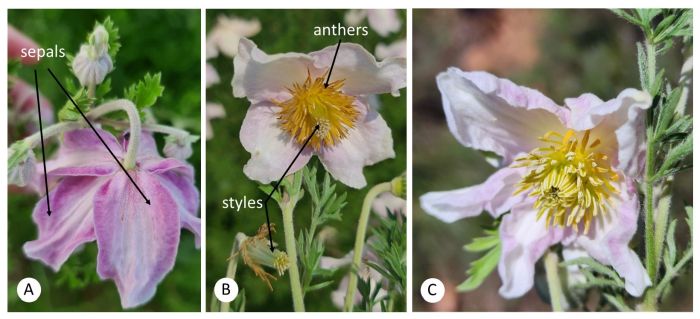
Fig. 3. Floral parts of Clematis villosa subsp. stanleyi. A, sepals. B, C, anthers and styles. All photos: SP Bester.
The reproductive structures include filaments that are 8 mm long and covered in fine hairs, yellow anthers measuring 4 mm, and densely feathery (plumose) styles that are 10–12 mm long. The plant produces fruit in the form of an aggregate of achenes, forming a head up to 100 mm in diameter. The fruiting structure is held upright, with each individual achene ending in a persistent, feathery style.
Flowering occurs in summer, between November and April, with peak blooms typically in midsummer, from December to January.
Conservation Status
Status
This species is considered a near-endemic to South Africa and is widely distributed across Gauteng and neighbouring regions in Limpopo, North-West and Mpumalanga provinces. It thrives in highly disturbed areas and tends to increase in abundance where thickets expand due to fire suppression and poor land management.
Although much of its natural range has been converted into urban areas, there is no evidence of a population decline. As a result, it has been classified as Least Concern (LC) according to the assessment for the Red List of South African Plants by Von Staden (2017).
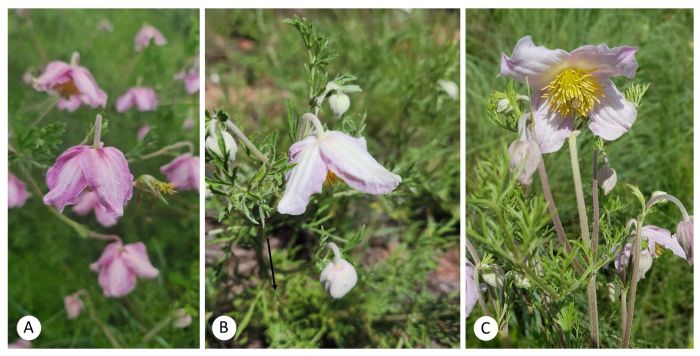
Fig. 4. Clematis villosa subsp. stanleyi flowers. A, B, showing habit of the plants with hanging flowers. C, typical flower viewed from below. All photos: SP Bester.
Distribution and habitat
Distribution description
It is widespread across northern South Africa (Gauteng, North-West, Limpopo and Mpumalanga provinces), from the Witwatersrand to the Waterberg and Middelburg in Mpumalanga. It further extends to Botswana and Namibia and northwards to Angola (?) and Zambia.
Plants grow in open woodland and grassland, especially in sandy soil and on rocky ridges or ledges. The veerbossie (feather bush) has been reported to grow in altitudinal ranges from 400−2 050 m.a.s.l. In its natural habitat it is a tough plant growing in usually acidic, nutrient-poor soils where it is regularly exposed to frost in winter, periodic droughts and veld fires. In Zimbabwe it is found in the drier parts of the country, particularly on Kalahari sand.
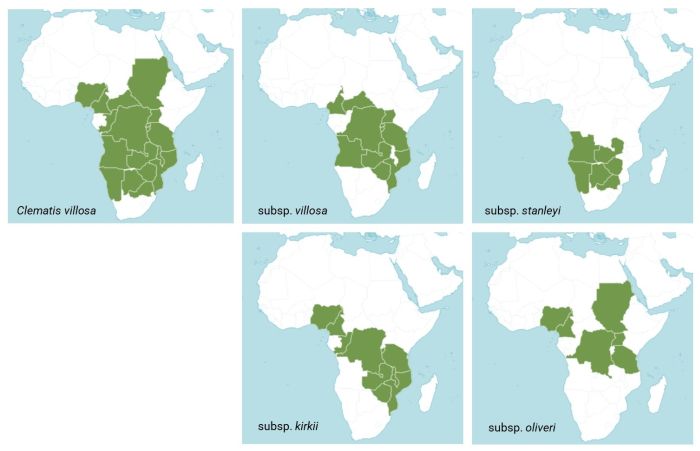
Fig. 5. Distribution maps of Clematis villosa and the four subspecies recognised within it. Images derived from Plants of the World Online.
Derivation of name and historical aspects
History
The generic name Clematis originates from the ancient Greek word klématis meaning ‘climbing plant’ or ‘vine branch’ and is befitting as most species are climbing or vining plants. The name was later adopted into Latin and then into modern botanical classification. The specific epithet villosa is in reference to the greyish to white hairs that cover all parts of the plant. The subspecies name stanleyi was given in honour of the well-known British naturalist and politician, Edward Smith Stanley (1775−1851), who was a leader in the science of zoological classification, and became Lord Derby in 1834.
The vernacular names feather duster and veerbossie (feather bush) are in reference to the mature fruits carried on the plant that look like feathers due to the persistent long white hairs on the styles when the fruits are ripe.
The genus Clematis belongs to the Ranunculaceae (buttercup family) and consists of approximately 300 species of flowering plants. These plants are mainly climbing vines, although some species are herbaceous or shrub-like.
In its wide distribution range plants are very variable, especially in leaf form and inflorescence, which resulted in various epithets given to it. In the most recent revision of the group four subspecies are recognised within Clematis villosa. This subspecies differs from subsp. kirkii in the much more finely divided leaves with linear-elliptic ultimate segments. Putative hybrids with Clematis brachiata have been reported.
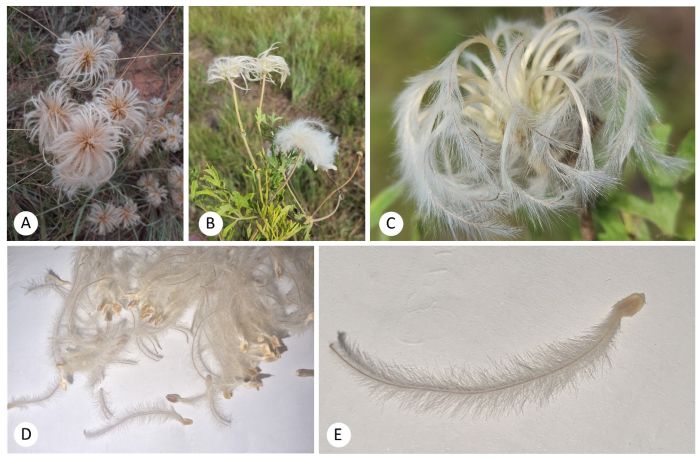
Fig. 6. Clematis villosa subsp. stanleyi fruiting heads. A−C, mature fruits in aggregated heads on plants. D, seed collected for propagation trials. E, single achene with persistent feathery style. Photos: A−C, SP Bester; D, E, D Dibakwane.
Ecology
Ecology
The ripened achenes on the flower head remain on the plant for some time before individual seeds eventually break off and are carried away by the wind. The feathery styles attached to the achenes aid in wind dispersal. Additionally, these structures may help the seeds burrow into the soil, like the mechanism observed in certain Stipagrostis grass species. Sowing trials suggest that the seeds require a period of maturation after being released, which typically occurs in autumn. They remain dormant through the unfavourable winter months and only begin to germinate in the following spring.
The flowers attract a variety of insects, including bees and beetles, which may serve as pollinators. The flowers not only support beneficial pollinators like bees but also attract visually striking insects such as butterflies, enhancing their ecological value.
Uses
Use
Various Clematis species have been cultivated in Europe since at least the 16th century, primarily for their ornamental value. Their striking flowers and climbing growth habit have made them popular in gardens and landscapes worldwide. Over time, numerous modern hybrids have been developed to enhance their decorative appeal.
In Japan and China, some Clematis species are used in traditional herbal medicine. However, there is limited documentation on their uses in southern Africa, though some sources suggest medicinal applications. This species, along with Hermannia geniculata, has been used as a remedy for chest ailments, including coughing up blood (haemoptysis). The leaves are sometimes rubbed against teeth or a burnt branch inserted into a cavity to relieve toothache. Additionally, dried and powdered roots or leaves are used as a snuff to ease headaches.
Known locally as pluimbossie (plume bush), this plant can be grown in wild gardens within its natural habitat or cultivated in pots outside its native range, provided environmental conditions are carefully replicated. Although its flowers are striking, they have a short lifespan, making them unsuitable for cut flower arrangements. However, when planted in clusters, it can create a visually stunning focal point in wild gardens or rockeries.
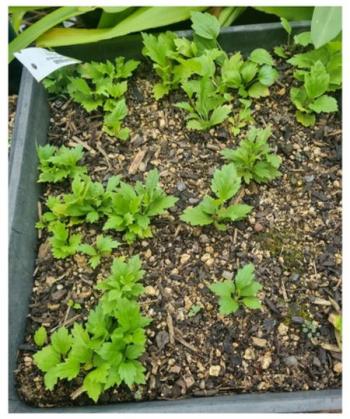
Fig. 7. Clematis villosa subsp. stanleyi seedlings growing in seed tray. Photo: D Dibakwane.
Growing Clematis villosa subsp. stanleyi
Grow
Clematis villosa subsp. stanleyi is not commonly available from nurseries, meaning gardening enthusiasts and naturalists must rely on wild-collected seeds or experiment with propagation techniques, such as cuttings.
Two horticulturists have noted that growing this plant from seed can be challenging. Arnold Frisby successfully germinated a few freshly collected seeds by planting them about 1 cm deep in a sandy mix with compost in a 15 cm deep pot. Sowing was done in spring or early summer, with the pot placed in a warm, sunny location and kept consistently moist. Germination took at least a month. The plants developed large woody roots early on and were potted up after a year. Plants should be allowed to dry out and go dormant in winter to prevent rot.
According to Dineo Dibakwane (DD), a horticulturist at the Walter Sisulu National Botanical Garden, propagation of Clematis villosa subsp. stanleyi differs much from its relative, Clematis brachiata. According to Matt Prinsloo, overwintering the seeds increases germination success. In 2024 DD, conducted germination trials with seeds subjected to different treatments: smoke exposure, soaking in warm water, soaking in smoke water and microwaving. A control group of untreated seeds was also included. All seeds, including the control, germinated within four months, with no significant differences among the treatments. This suggests that the seeds may naturally require a specific seasonal trigger for germination, necessitating further research. Cuttings taken in mid-summer and treated with soft tissue hormone failed to root, indicating a need for further trials to determine the optimal timing and techniques for successful propagation.
Recommended best practices for propagation: Sow seeds in spring (September or October) in well-drained seedling mix. Keep trays moist, in a warm, shaded area. Germination typically occurs within 3–5 weeks. Transplant the seedlings when the first true leaves develop. Take semi-hardwood cuttings in spring, when the new growth begins to harden. Use a suitable propagation medium and rooting hormone, keeping the cuttings moist but not overly wet. Rooting takes approximately 4–6 weeks, after which the rooted cuttings can be potted up. Side branches that have rooted naturally can be separated from the parent plant to form independent plants. Plants can also be propagated by layering: bend a low-growing stem down to the ground and cover the nodes with soil, and keep the area moist until roots develop. Slightly wounding the underside of the buried stem may improve rooting success.
By following these guidelines and mimicking natural growth conditions, gardeners can increase their chances of successfully cultivating Clematis villosa subsp. stanleyi.
In the garden, Clematis villosa subsp. stanleyi thrives in full sun or partial shade in sandy soils. Seedlings and young plants require frequent and regular watering, but once established, they become self-sustaining and watering can be significantly reduced and should mainly occur during the active growing season (spring to autumn). During dormancy in winter, watering should be withheld.
The plant is frost-hardy, as its rootstock is protected underground. There is no need to prune when it goes dormant, but dead biomass should only be removed once it has naturally dried out for aesthetic purposes in a garden setting.
When grown in containers, seedlings should be transplanted into moderate-sized pots after establishment. The plant can grow up to 1.5 x 1.5 meters and does not tolerate frequent disturbance once potted. It is best suited for wild gardens or rockeries, where it serves as a striking focal point when planted in mass. Because it is a perennial that dies back in winter, it pairs well with plants that provide foliage during its dormant phase. It also adapts well to container gardening, allowing for relocation during dormancy.
This species appears to be relatively pest-free both in cultivation and in the wild. Observed damage from pests was mainly the eating of buds and floral parts. Plants form a rounded shape with attractive flowers that also attract pollinating insects such as bees.
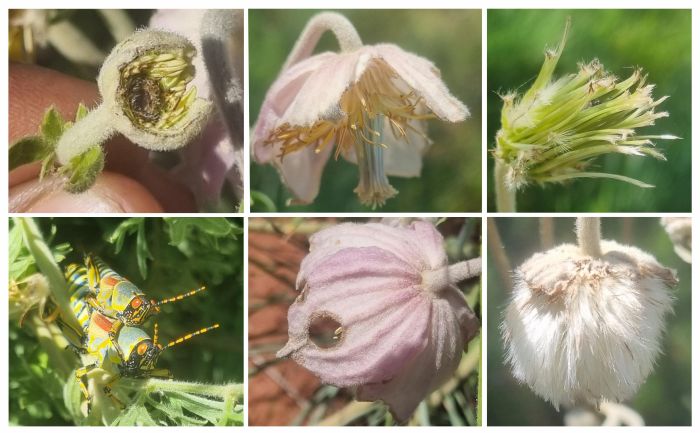
Fig. 8. Clematis villosa subsp. stanleyi damage caused by pests. Photos: D Dibakwane.
References
- Brummitt, R.K. 1976. Notes arising from the Wye College expedition to Malawi. 1. A reconsideration of Clematopsis (Ranunculaceae) in Africa, with special reference to Malawi. Kew Bulletin 31: 155−162.
- Brummit, R.K. 2000. Inclusion of Clematopsis Hutch. In Clematis L. (Ranunculaceae). Kew Bulletin 55: 97–108.
- Exell, A.W. & Milne-Redhead, E.W.B.H. 1960. Ranunculaceae In: Flora Zambesiaca 1(1)89−102. Crown Agents for Oversea Governments & Administrations, London.
- Germishuizen, G. & Fabian, A. 1997. Wild flowers of northern South Africa. Fernwood Press, Vlaeberg, Cape Town.
- Harvey, W.H. 1859. Ranunculaceae. In: W.H. Harvey and O.W. Sonder (eds). Flora Capensis I (Ranunculaceae-Connaraceae):1-7. Hodges, Smith and Co., Dublin.
- Hutchinson, J. 1920. Clematopsis, a primitive genus of Clematideae. Bulletin of Miscellaneous Information (Royal Botanic Gardens, Kew) 1920(1): 12−22.
- Hyde, M.A., Wursten, B.T., Ballings, P. & Coates Palgrave, M. 2025. Clematis villosa subsp. stanleyi. Flora of Caprivi: Online. https://www.capriviflora.com/speciesdata/species.php?species_id=123540.
- Joffe, P. 1993. Die tuinier se gids tot Suid-Afrikaanse plante. Tafelberg Uitgewers Kaapstad.
- Kuntze, C.E.O. 1885. Monographie der Gattung Clematis. Verhandlungen des Botanischen Vereins der Provinz Brandenburg und die angrenzenden Lander 26(2): 83−202.
- Letty, C., Dyer, R.A., Verdoorn, I.C. & Codd, L.E. 1962. Wild flowers of the Transvaal. Wild flowers of the Transvaal Book Fund, Pretoria.
- Lucas, A. & Pike, B. 1971. Wild Flowers of the Witwatersrand. Purnell, Cape Town.
- Pienaar, K. 1991.Gardening with indigenous plants. Struik Timmins Publishers, Cape Town.
- Phillips, E.P. & Gower, S.I. 1923. Clematopsis stanleyi Hutchinson. Flowering Plants of South Africa 3: t.81.
- Plants of the World Online. Clematis villosa DC. https://powo.science.kew.org/taxon/urn:lsid:ipni.org:names:710182-1. Accessed on 2025/02/24.
- Retief, E. & Herman, P.P.J. 1997. Plants of the northern provinces of South Africa: keys and diagnostic characters. Strelitzia 6. National Botanical Institute, Pretoria.
- Saunders, R. 1995. Clematis brachiata x Clematopsis scabiosifolia. Veld & Flora 81(2):45.
- Smith, C.A. 1966. Common names of South African plants. Memoirs of the Botanical Survey of South Africa No. 35. Government Printer, Pretoria.
- Van Wyk, B. & Malan, S. 1988. A field guide to the wild flowers of the Witwatersrand and Pretoria region. Struik, Cape Town.
- Van Wyk B.-E. & Gericke, N. 2018. People’s plants – a guide to useful plants of southern Africa. 2nd edition. Briza Publications, Pretoria.
- Viljoen, C. 2002-3. Clematis brachiata Thunb. (Ranunculaceae). PlantZAfrica. Online. https://pza.sanbi.org/clematis-brachiata.
- Viljoen, C. 2019-4. Clematis brachiata x villosa ‘Silver Beard’. (Ranunculaceae). PlantZAfrica. Online. https://pza.sanbi.org/clematis-brachiata-x-villosa-‘silver-beard’.
- Von Staden, L. 2017. Clematis villosa DC. subsp. stanleyi (Hook.) Kuntze. National Assessment: Red List of South African Plants. http://redlist.sanbi.org/species.php?species=2009-56.
- Watt, J.M. & Breyer-Brandwijk, M.G. 1962. The medicinal and poisonous plants of southern and eastern Africa , edn 2. Livingstone, Edinburgh & London.
Credits
SP Bester, National Herbarium, Pretoria, Foundational Research and Services Division, Botanical Research Directorate
and Dineo Dibakwane, Walter Sisulu National Botanical Garden
March 2025
Acknowledgements: the authors thank horticulturists Arnold Frisby, Matt Prinsloo and Andrew Hankey for sharing their knowledge and observations of how to grow plants from seed.
Plant Attributes:
Plant Type: Perennial, Shrub
SA Distribution: Gauteng, Limpopo, Mpumalanga, North West
Soil type: Sandy, Loam
Flowering season: Late Summer, Autumn
PH: Acid
Flower colour: White, Pink, Cream
Aspect: Full Sun, Morning Sun (Semi Shade), Afternoon Sun (Semi Shade)
Gardening skill: Challenging
Special Features:
Horticultural zones
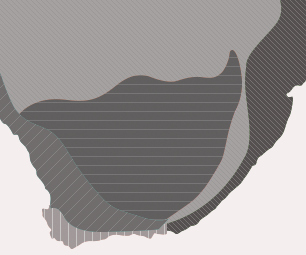








Rate this article
Article well written and informative
Rate this plant
Is this an interesting plant?
Login to add your Comment
Back to topNot registered yet? Click here to register.